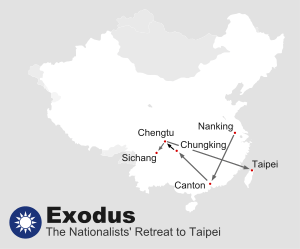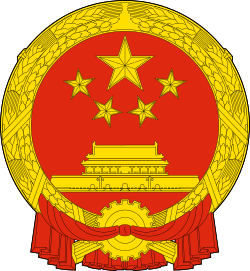China–Singapore relations
 |
|
China |
Singapore |
|---|---|
 |
|
Singapore |
Taiwan |
|---|---|
People's Republic of China – Singapore relations officially started on October 3, 1990. [1] Diplomatic missions were established in the early 1990s based on trade and the warming of ties from other ASEAN countries towards mainland China.
Singapore–Taiwan relations were the international relations between Singapore and Taiwan that peaked during the 2015 Ma–Xi meeting in Singapore. Taiwan has a representative office in Singapore. Singapore operates the Singapore Trade Office in Taipei in Taiwan, both of whom are members of the World Trade Organization (WTO).
History
Historic links between the two nations' people began much earlier than the founding of the People's Republic of China in October 1949. As a colonial state under British Malaya rule, most early Chinese migrants came as labourers into Singapore escaping poverty and war. They came to what was known as Nanyang to the Chinese to Singapore, which was part of the Straits Settlements. Many ethnic Chinese Singaporeans derived their ancestral roots in southern China from Fujian, Guangdong and Hainan provinces.[2]
In the 1970s, People's Republic of China and Singapore began unofficial relations. This led to the exchange of Commercial Representatives' Offices between the two nations in 1981. In 1985, commercial air services between mainland China and Singapore commenced.[1]
Diplomatic ties between the two countries officially began in 1990. On 3 October 1990, Singapore revised diplomatic relations from the Republic of China to the People's Republic of China. The relationship between Singapore and the PRC has since improved significantly.[3] In 2004, shortly before the current Prime Minister of Singapore Lee Hsien Loong took office from the then incumbent Goh Chok Tong, he made a visit to Taiwan to familiarise himself with the latest developments there.[4] Bilateral ties took a dive.[5] The People's Republic of China took offence to the trip due to the complicated political status of the region[5] Later in 2004, Chinese government put bilateral relations on hold.[6] In his maiden National Day Rally speech, Lee criticized the Taiwanese leadership and populace of overestimating the support they would receive if they were to declare Taiwan independence;[7]
Singapore was the last country in South East Asia to formally recognise the People's Republic of China out of respect to Indonesia, North Korea and Thailand, sensitivities in the region and fears from neighbouring countries of communism in those times.[8] Singapore still maintains unofficial relations with the ROC, including the continuation of a controversial military training and facilities agreement from 1975.[9] This is due to a lack of usable space in built-up Singapore.[9] The People's Republic of China Chinese government has officially offered Singapore to shift its training facilities from Taiwan to Hainan Island,[9][10][11] with official annual military exercises known as Exercise Starlight (星光計畫)[12] in Taiwan.
Relations between the two countries gradually improved as China and Singapore forged agreements in free trade, education, foreign investment, modern armament and technology.[1] Examples are the Suzhou Industrial Park and the Sino-Singapore Tianjin Eco-city, which were constructed with the help of Singapore.
Singapore has taken neutral stance on the ongoing Territorial disputes in the South China Sea. In 2016, the Chinese state media controlled Global Times accused Singapore of raising the issue with the Non-Aligned Movement by filing complaint about China's actions. This prompted Singaporean ambassador to China Stanley Loh to deny accusations as nothing more but fabrications. An influential Chinese military advisor however issued threat that "Beijing should make Singapore pay the price for seriously damaging China's interests with retaliations and sanctions".[13]
Taiwan
As an island, Taiwan was known before World War I as the Republic of Formosa, with Taiwan under Japanese rule occurring between 1895 and 1945. It is geographically separate from Mainland China where the Kuomintang (KMT) party first began. During World War II, the KMT party that came to found the Republic of China was also part of the formation of the Reorganized National Government of the Republic of China in Mainland China, within the Japanese Greater East Asia Co-Prosperity Sphere.

With the surrender of Japan after the world war, the republic broke into three separate entities, specifically China or the "People's Republic of China", Mongolian People's Republic, and Taiwan or the "smaller Republic of China" where surviving KMT forces retreated after losing the war against the Chinese communists; at the same time Singapore returned under British Malaya as a colonial state.
Like Thailand where Singapore today adopted modern military training bases with, Taiwan was also under Japanese Greater East Asia Co-Prosperity Sphere influence leading up to post-World War II. Strategically, the Japanese occupation of Singapore and the Japanese occupation of Malaya was made possible and expedited because of Thai and Taiwanese varied involvements and / or assistances towards the Japanese war efforts. Since the independence of Singapore and the establishment of Kuomintang rule over the island of Taiwan, the Singapore Armed Forces (SAF) adopted military training bases in Taiwan from 1975 that included combined arms exercises involving infantry, artillery, and armored units. The then Prime Minister of Singapore Lee Kuan Yew also appointed Taiwanese military personnel in training Republic of Singapore Air Force. These exercises, engaging as many as 10,000 troops at one time, provided officers a chance to simulate wartime conditions more closely and gain experience in the command and control of operations involving several battalions.[14]
With waning Taiwan diplomatic significance, the People's Republic of China has since succeeded the governance of mainland China in the aftermath of the Chinese Civil War.[15] Attempts by the 2016 newly elected Taiwanese government in turning to South East Asian nations such as Singapore is subtly deemed as separatist.[16]
Bilateral relations
The bilateral trade between China and Singapore developed rapidly in recent years and Singapore has maintained the first position among ASEAN countries in their trade with China.[1] China's transformation into a major economic power in the 21st century has led to an increase of foreign investments in the bamboo network, a network of overseas Chinese businesses operating in the markets of Southeast Asia that share common family and cultural ties.[17][18]
In 1998, volume of trade was US$8.154 billion in 1998.[1] In 1999, the trade value has increased to US$8.56 billion.[1] In 2000, the amount increased to US$10.821 billion.[1] In 2009, the total trade volume was SGD 75.1 billion (USD 58.4 Billion).[19]
Singapore is China's 9th largest trading partner.[20] While China is Singapore's 3rd largest trading partner which consisted of 10.1 percent of Singapore's total external trade from the previous year.[21]
China's export to Singapore were textiles, clothing, agriculture produce, petrochemical, metals, electromechanical equipment, feed, coking coal, shipping, machinery supplier, communication equipment and electronic components.[1]
Companies such as Capitaland and Breadtalk have made substantial inroads into China's domestic economy.[22][23][24] Others such as Temasek Holdings, Singapore Airlines have each invested in China Eastern Airlines.
In November 2015, China opened the China Cultural Centre in Singapore.
See also
Bibliography
- Cardenal, Juan Pablo; Araújo, Heriberto (2011). La silenciosa conquista china (in Spanish). Barcelona: Crítica. pp. 258–261.
References
- 1 2 3 4 5 6 7 8 "Brief Introduction to Relations between China and Singapore". Xinhua News Agency. 2002-05-17.
- ↑ John Wong. "Sino-Singapore Relations: Looking Back and Looking Forward". Singapore China Friendship Association. External link in
|publisher=(help) - ↑ Kastner, Jens. "Taiwan-Singapore soup turns bitter-sweet". Retrieved 4 April 2015.
- ↑ "China warns Singapore officials against future visits to Taiwan". Singapore-window.org. 2004-08-26. Archived from the original on July 16, 2012. Retrieved 2012-11-20.
- 1 2 http://www.china-embassy.org/eng/xw/t142816.htm
- ↑ BBC Monitoring Asia Pacific,1 (21 February 2005). "Chinese ambassador says ties with Singapore fully restored". ProQuest ANZ Newsstand. 795797051. .
- ↑ "Prime Minister's Office - National Day Rally Videos & Speeches". Nettv.1-net.com.sg. Archived from the original on September 20, 2012. Retrieved 2012-11-20.
- ↑ http://countrystudies.us/singapore/59.htm
- 1 2 3 http://www.taipeitimes.com/News/taiwan/archives/2002/04/23/0000133008
- ↑ http://www.singapore-window.org/sw02/020922a3.htm
- ↑ "A David-and-Goliath tussle: FEER". Singapore-window.org. 2004-08-05. Archived from the original on July 16, 2012. Retrieved 2012-11-20.
- ↑ "星光計畫 - 台灣大百科全書 Encyclopedia of Taiwan". Taiwanpedia.culture.tw. 2012-11-16. Retrieved 2012-11-20.
- ↑ http://www.ibtimes.co.uk/chinese-military-adviser-says-singapore-should-pay-price-south-china-sea-spat-1584308?utm_source=yahoo&utm_medium=referral&utm_campaign=rss&utm_content=/rss/yahoous/news&yptr=yahoo
- ↑ "Singapore's Tightrope Walk On Taiwan | Center for Strategic and International Studies". Csis.org. Archived from the original on May 8, 2011. Retrieved 2012-11-20.
- ↑ "Increased recognition of China weakens Taiwan's claims". Straits Times. 22 June 2016. Retrieved 26 June 2016.
- ↑ Tay, Simon. "In turning to S-E Asia, Taiwan has to keep China in mind". Retrieved 26 June 2016.
- ↑ Quinlan, Joe (November 13, 2007). "Insight: China's capital targets Asia's bamboo network". Financial Times.
- ↑ Murray L Weidenbaum (1 January 1996). The Bamboo Network: How Expatriate Chinese Entrepreneurs are Creating a New Economic Superpower in Asia. Martin Kessler Books, Free Press. pp. 4–8. ISBN 978-0-684-82289-1.
- ↑ "Archived copy" (PDF). Archived from the original (PDF) on 2010-11-13. Retrieved 2011-01-04.
- ↑ "Archived copy". Archived from the original on 2013-01-18. Retrieved 2013-01-12.
- ↑ Xinhua (July 9, 2010). "Singapore exports benefit from FTA with China". http://www.china.org.cn/. External link in
|publisher=(help) - ↑ Sonia Kolesnikov-Jessop (December 21, 2010). "Bakeries Claim a Growing Niche in China". I.H.T. Special Report: Doing Business in China. http://www.nytimes.com. External link in
|publisher=(help) - ↑ www.chinaknowledge.com/ (December 31, 2010). "CapitaLand China to sell stake in Senning Property". chinaknowledge.com. External link in
|publisher=(help) - ↑ http://www.capitaland.com.cn/en/52_ENU_HTML.htm
External links
- Chinese Embassy in Singapore (Chinese)
- Singapore Embassy in Beijing (Chinese)

.svg.png)